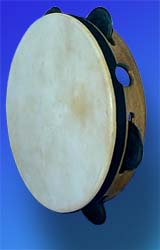The Italian Tamburello
By Andrea Piccioni
Inside the world of percussion there are many huge and unexplored
areas, often even by professionals. The rhythm experience leads
us back to the beginning of the human race, followed us during our
evolution and is still present in artistic expressions of our every
day life (the beating of the heart, a train passing by... ).
 No
other instruments have the same popularity and diversification.
If we consider the membranophone instruments we find boxes, frames
drums, barrel drums, pot drums, goblet drums, square drums, hexagonal
drums, round drums, cylindric, conical, spherical, and so many more. No
other instruments have the same popularity and diversification.
If we consider the membranophone instruments we find boxes, frames
drums, barrel drums, pot drums, goblet drums, square drums, hexagonal
drums, round drums, cylindric, conical, spherical, and so many more.
Also the methodologies used to obtain the sound took different
applications, starting with hands with a variety of different techniques
using, depending on the instrument, the hand flat, cupped, postioned
in many strange ways to end with the use of the fingers with very
sophisticated techniques. Investigating further we find a large
number of tools to improve the range of nuances of the sounds.
The frame drums are among those instruments which were, till some
years ago, almost unknown to the public: for what concerns the Italian
Tamburello is still partly the same. Argument of the present work
will then be the Italian Tamburello, which belongs to the immense
family of the frame drums. It does not have the pretension to be
exaustive in such a large and complex argument, since many musical
forms and styles are still being discussed and studied; this would
like to be a simple contribution to the promotion of this wonderful
instrument and, consequently, of an important part of the italian
culture and tradition.
 at
left: 45 cm diameter tamburello with 7 couples of jingles at
left: 45 cm diameter tamburello with 7 couples of jingles
We will define as "tamburello" a frame drum with one
skin, with different size (varying from 15 to 60 cm), which often
has inserted in the frame rings, bolts or series of jingles. The
tamburello structure is obtained curving a band of wood, giving
it a circular form. One of the traditional methods, mostly in the
mediterranean area, consists in curving the wood after it has been
heated using vapor. The frame obtained is very similar to the common
sieve and in fact, especially in the mediterranean area, the tamburello
makers were the same artisans who made the sieves use by the peasants.
The skin is fixed on one side of the frame and it's streched and
maintained tense with nails, tensors, thorns or glue. It's quite
common to find a wood wrap applied on this part of the skin to protect
and reinforce it. Some holes are opened on the frame where the jingles
are placed.
The most commonly used skin are of kid, dog, cat or donkey. In
some parts of Calabria, where the technique prefers a most closed
and dark sound, they sometimes use untreated skins which sometimes
still have the hair, so that middle-high harminics are dampened.
In Sicily on the contrary, where the supreme playing technique uses
all the sound possibilities of the skin, they usually prefer to
use very refined and well treted skins, tense and quite thin.
Synthetic skins have been introduced in the market during the last
years; these skins while they do not change the pitch depending
on weather changes and have a great sound volume, do not maintain
the rich variety of harmonics typical of the natural skins.
In Italy there is another family of frame drums, specifically
located in Campania, the Tommorra. This is different from the Tamburello
because of his structure, tradition, playing technique and musical
forms. One of the first historical documents of this instrument
is the well known mosaic in Cicerone's house in Popmei (1st century
B.C.); since this first document the Tammorra has been represented
in many documents throughout the centuries and it's thanks to these
documents that we are able to see that it's structure (including
the decorations on the frame), the morphologic characteristic and
the playing styles remained unchanged over a period of more then
two thousands years.
Because of the complexity of this argument, the Tammorra will be
presented in a separated article.
 History History
The Tamburello is surely the most popular and important
percussion instrument in italian popular musical tradition. It's
currently still played and made according to the traditional methods
in most part of the italian territory: particularly in Abruzzo,
Lazio, Marche Basilicata, Puglia, Molise, Campania, Calabria, Sicilia
and Sardegna (the tadazzeddu, a small drum without jingles is played
in the region of Sarrabus, but different researchers consider it
has been only recently introduced in the musical tradition). In
recent years the Tamburello can be found in the musical tradition
of Piemonte, Valle D'Aosta, Veneto and the Istrian-Venetian communities
in the ex Yugoslavia territory.
The Tamburello has benn probably instriduced in Italy thanks to
the Greek influence in the southern part of the peninsula, as represented
in different documents of the 5th to 7th centuries B.C.
Then an additional influence that contributed to the spread of
the Tamburello, is the long presence of the Arabian-Moslem culture,
especially in Sicily. This island played and important role since
it has been the bridge for the introduction, in the first Middle
Age, of different elements of the Arabian musical tradition, besides
of many musical instruments: liuto, oboes, double headed drums,
some goblet drums, the Tamburello.
Even if it is clear that the Islamic culture contributed to diffuse
the use of this instrument in the mediterranean area or to reinforce
its use where it was already known, it was widely played in the
Middle East and North Africa many centuries before.
In a large series of documents from Mesopotamia, Egypt, Middle
East, classical Roman period and Greek, we can find the representation
of many different types of tamburello, some of them identical to
those played nowadays. For example in both the Mesopotamian and
Egyptian cultures, was in use a square frame drum very similar to
others still played in the Mediterranean area (the Arabian duff)
or in Galicia (pandeiro). Circular one headed drums are represented,
for what concerns the Sumerian era on the Bismya pot (Oriental Museum
of Chicago), for the UR culture on the Ur-Nammu stone (Philadelphia
University Museum); for the Babalonian era on the bassorilievo of
around 1700 ( Voderasiatischen Museum in Berlin); for the assirian
culture the Ninive documents of 600 B.C. (Louvre Museum, Paris).
The period of time covered only by these documents higlights a
period of presence of this instrument of more then five thousands
years.
 Morphological characteristics of the Tamburello
Morphological characteristics of the Tamburello
at right: beautiful Eckermann
tamburello
Dimensions
Dimensions can widly vary depending on some specific elements: geographicalregion,
available materials, the playing techniques poper of the region,
the drums maker's style, the musical genre for which the instrument
will be used.
The most important element which most incluences the drums makers
is the playong technique used in the specific region or the music
syle for which it will be used. This leads to a certain standar
of the instruments used by the players.
For example in Marche, Molise and Abruzzo there has been and there
still is a prevalence of small-medium instruments (20-30 cm of diameter).
These are very light instruments with a high pitch sound, good for
the music styles in those regions in whch the jingles sound is sually
more important the the sound produced by hitting the skin; the most
common tecnique uses strokes on the edge of the drum along with
a shaking movement of the left hand. For this reason small instruments
with a non sonorous skin and a light structure are prefered.
In the Campania and Salento regions, even if small instruments can
be found, the playing technique gives more importance to the sound
prodiced by the skin using the whole hand or the thumb. Instruments
suitable for this playing style are bigger (40-50 cm of diameter)
and heavy.
In Sicily we can find instruments of different sizes and each drums
maker usually have two or three standard sizes, but the tendency
is to have medium-large instruments (60 cm of diameter) with specific
care about the sound of the skin, the jingles and the instrument's
weight. The complex playing techniques of this region can in fact
higlight the sound of jingles or of the skin independently. Bigger
instruments better allow players to modulate the different sound
nuances and the light weight allows a great dynamism in the shaking
movement of the left hand.
Skins
The most common skins are of kid or lamb skins.
The tanning technique does not use salt, to reduce the tightness
and the looseness of the skin due to athmosferic conditions changes.
In Calabria, mostly in the past, cat skin was often used, which
is thicker and less elastic then kid and lamb skins: for this reason
it's good for the less resonant and "dirty" sound tipical
of that region. In the Reggio Calabria area it's still alive the
habit of dropping some wine inside the drum directly on the skin.
This practice, if on one side has the effect of loosen the skin,
on the other side it surely reminds votive practices of pagan origin.
Sometimes in Calabria, and probably also in Sicily, it is possible
to find non-treated skins with the animal hair still on the skin,
with the puropose of smoothing the sound. In Campania drums using
donkey skin can still be found (even if it was more common in the
past), which is good for the playing technique used in that area,
thanks to its stenght. In the province of Cogne (Valle d'Aosta -
extreme north of Italy on the border with France) the tamburello
is made with chamois skin.
Techniques of mounting the skin on the drum
The skin is usually mounted on the skin using glue and small nails.
In the Salento region and in the province of Reggio Calabria they
use thorns, which besides avoiding problems due to oxidation allow
to change the skin tension.
In Campania, Lazio, Abruzzo and some parts of Puglia and Calabria,
the skin is mounted directly on the drum. In other regions a wooden
band is added to protect where it's fixed to the drum. In Sicily
they also use to add a second wooden band on the open side of the
drum.
In many cases the skin is not mounted on the drum body but to a
metal ring to which metal tensors are fixed. This practice was already
in use in Italy in the 18th century.
Jingles
The practice of adding one or more series of jingles in hole opened
on the drum body, is very old and common to all the italian drums
except in Veneto, where the use of the tamburello has been lost
during the previous century and the only instruments we can find
there do not use jingles at all.
In some cases besides or in place of the jingles, they use small
rings or other metal objects, usually fixed inside the drum body
with a string placed horizontally. In Campania, Cilento and some
other regions it's common the practice of adding a castanet inside
the drum touching te skin. In Calabria it is possible to find drums
with wooden jingles, which sound is less resonant and loud.
 at
left: tamburello with thorns-anchored skin at
left: tamburello with thorns-anchored skin
© 2004, Andrea Piccioni all rights reserved
|

